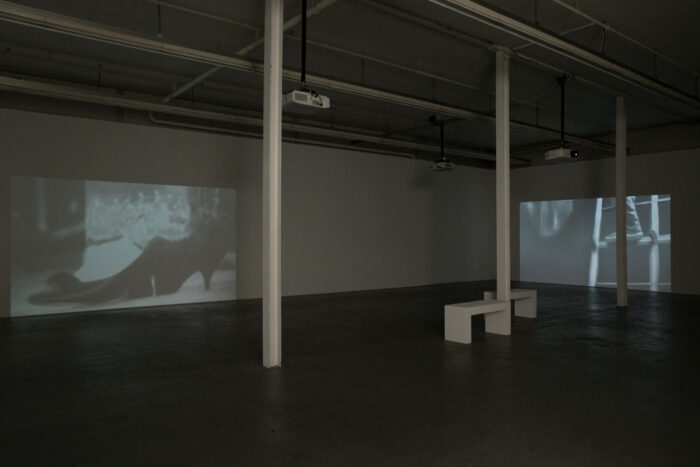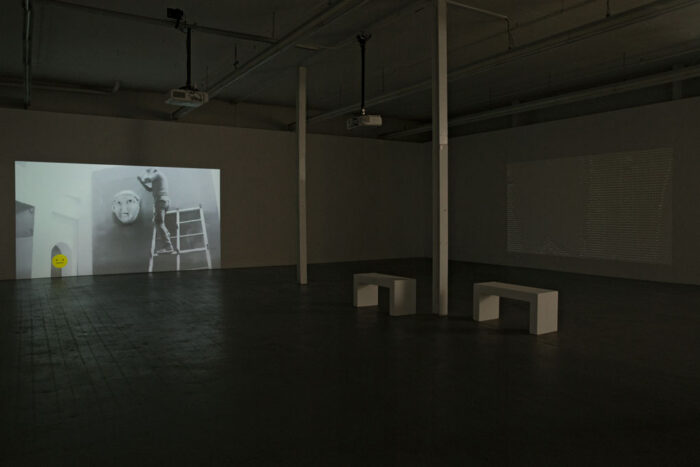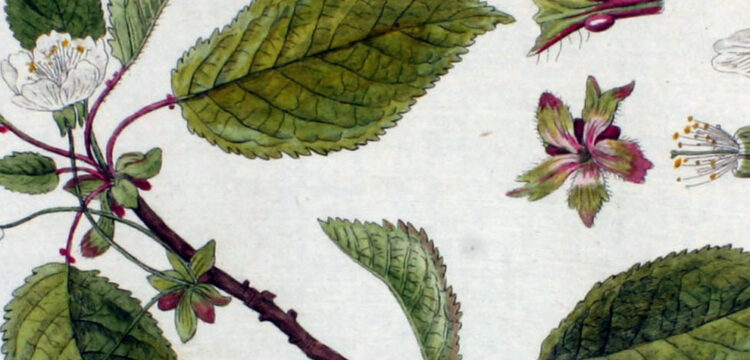Overturning Adversarial Dynamics
Sharif Waked in conversation with Ines Goldbach
The work of Sharif Waked investigates cultural and political moments in present and past histories, playfully juxtaposing different positions and narratives and generating paradoxical and absurd encounters. His oeuvres—ruminations on the meaning of making and seeing art in the digital era—are based in notions of appropriation, translation, and the juncture between image and text.
Ines Goldbach: While walking through your exhibition at Kunsthaus Baselland, watching the short videos from your series Just a Moment, the viewer witnesses fragments of our society in which culture is deconstructed at best, or destroyed at worst. From world heritage sites vandalized by ISIS in Iraq in Just a Moment No. 17 (Smiley) (2016) to the subtle foot stamping of the great Egyptian singer and activist Umm Kulthum—a cult figure and a symbol of emancipation in the Arab world in the 1960s—in Just a Moment No. 4 (Away from You) (2011). You also have Bath Time (2012), in which reality is literally and metaphorically washed out, revealing its deceptive nature. Considering what has happened and is still happening worldwide—destructive forces that aim to obliterate culture, individual and collective freedoms, human rights—it’s “just a moment” that makes a difference, whereas building up culture takes neither moments nor hours, but years and centuries. What inspired the Just a Moment series?
Sharif Waked: First of all, let me say a few words about Bath Time: you know the story behind this piece—in late 2009, the international media widely reported the transformation of two donkeys into zebras in Gaza. This cross-dressing of the species variety occurred at the hands of an entrepreneur whose zoo was badly damaged in the Israeli incursion earlier that year. His pair of zebras perished of starvation. Since buying a zebra and smuggling it through the Gaza tunnels was too expensive, the businessman opted to buy two local donkeys instead and paint them with stripes. It was a hit. Part of the thinking behind Bath Time was to imagine finishing a day’s work, washing the body paint off after a performance. What is washed away is not just the make-up but the marks that the gaze leaves behind. Let me add another dimension, and here I quote Diane Watteau, who in 2013 wrote about this work that “behind this question of a hidden animal, a dyed animal hiding another, of a donkey taken for a zebra, the idea of a stand-in double becomes an experience in which the artist proposes a world through representations and codes… Waked seizes reality, so that it does not appear current, “pirating” it by the story. It is not the evaluation of good and of evil that motivates his images. The critical project of the video artist does not establish a new morality; it thwarts identities by putting into resonance several systems of thought, several discourses. Unaccustomed and disquieting resentments, our familiar ideas and our dogmatisms: to charge the image with contradictory thoughts like a mask, which unmasks, creates a veritable aphoristic formula.”* And, by the way, you are right to point out deception, or fakeness, as mentioned above.

I had the feeling that the figure of the donkey, taking a bath but still bearing traces of the “other” identity, could also make us think of the many individuals, like us, who are leaving their home countries, their traditions, and maybe part of their identities, in order to be somewhere else, for whom the traces that life left behind are still visible: it might be a bit too personal, but is that also true for you?
Yeah, of course, in that interplay between being and becoming, there is always the remnant of traces. That was part of the consideration to not have a complete removal of the stripes, even after the bath is finished. As a side note, I am always careful when it comes to talking about identity. But let me portray a bit of family background that might be relevant to your question. I was born to parents who took refuge in Nazareth, not far from their village that was destroyed in 1948. Three of my eight sisters were born in that village. You can imagine the all-encompassing shift from farmers to laborers, from villagers to refugees. The traces of the past are ever present, sometimes as nostalgia, sometimes as metaphor. In a way it is like memory: it exists but it is always subject to the needs and desires of the present.

Basel, 2010. Photo Gina Folly. Courtesy the artist.
This leads me to your two-channel video Just a Moment No. 5 (Jericho First) (2012), which is also being presented at Kunsthaus Baselland. What is the story behind this work?
Just a Moment No. 5 (Jericho First) is based on an image from an eighth-century mosaic floor in Jericho depicting a lion attacking a fleeing gazelle. Taking its title from the first stage of the Israeli-Palestinian Oslo Accords, the work transforms and disguises a violent image. To give you some background, I quote again, this time Esther Dotan, who in 2003 wrote that “Georges Bataille links the passion for metamorphosis with curbed or repressed violence bound to erupt […]; but while the anticipated transformation follows the Little Red Riding Hood model—a metamorphosis from the innocent to the violent (the grandmother turned wolf)—Waked’s process is in reverse, therefore more uncanny, for it points at a screen of blindness, disallowing catharsis and a return to the innocent grandmother: the transition is from the overtly aggressive and violent—the scene in the mosaic—to manipulative disguise culminating in the abstract form that bleeds only as a distant metaphorical hint, and the decorative insect.”§
Should we be aware that the sudden change from good to bad is part of the history of every country, of every society? While standing in front of Just a Moment No. 5 (Jericho First) you hear the sound, the voice, of another work, To be continued… (2009), which is projected on the opposite wall of the same gallery at Kunsthalle Baselland. This video is quite impressive, and nearly everyone that enters the space takes a kind of step back… you see a man reading out a text, accompanied by weapons and signs… the whole imagery and setting reminds you of a suicide bomber. But in fact he is a storyteller—reading aloud from One Thousand and One Nights; in other words, he is actually trying to escape death through storytelling. Isn’t that true for our society worldwide? Aren’t we all trying to find stories to escape or avoid pain?
Yes, you could frame it as a sort of escapism, but I would prefer to see it as a moment of the triumph of art, the work of imagination, literature, and storytelling. There is a power here in overturning adversarial dynamics. Scheherazade∫ did, after all, propose to marry the king and she did it with a purpose: to save her gender. She brought her sister to the scene and told her exactly what to do and when to do it. You could say she had a plan. She proved to be an enormously gifted storyteller, armed with endless imagination that captivated the king, night after night, ultimately softening his heart and healing his wound. But you would still need a curious king for that plan to work. Moreover, the idea of the suspension of the moment through narration was what fascinated me. The suicide bomber is embroiled and complicit in a never-ending text that thwarts his plan.

I am intrigued by your work with Umm Kulthum—I believe I knew about her because of Shirin Neshat’s film Looking for Oum Kulthum (2017).
“Away From You,” which is part of the title of the video, is a reference to a song Umm Kulthum first performed in 1965. The work focuses on the stamping of the singer’s left foot just underneath a dress that scrapes her heel. Here I should mention another piece, not featured in the exhibition, titled Just a Moment No. 6 (You Are My Life) (2011), which consists of a song embodying the spectral presence of Kulthum’s handkerchief. In both pieces, the high-heeled shoe and the handkerchief are fashion codes. You know my fascination with fashion from my most well-known piece, Chic Point (2003), in which I present a fashion line I designed for Palestinians baring their flesh at Israeli checkpoints. As a side note, it’s funny to think of Umm Kulthum as an activist, although during most of her life, her music and her persona transgressed political regimes. In any case, in Just a Moment No. 4 (Away from You) and Just a Moment No. 6 (You Are My Life), the performer and the full orchestra are muted and excluded. The handkerchief and the high-heeled shoe repetitively tapping the floor take shape as seismographs. Both are extensions of the diva’s body and, at the same time, they take on a life of their own.
You would not believe it, but during the opening at Kunsthaus Baselland a very old lady came to see your exhibition; she traveled through different countries in the Middle East on her own in the late 1960s and 1970s and she immediately recognized the short sequence in Just a Moment No. 4 (Away from You) from Umm Kulthum’s performance at the Théâtre Olympia in Paris in 1967. From hearing and reading about her, I wonder whether people today look up to her as a political figure or consider her “just” a diva.
It is very nice to hear that. As far as my expertise in contemporary Arab music goes, I believe that Umm Kulthum is still a fertile source of inspiration. Let me mention another piece in this series, Just a Moment No. 20 (Allah) (2018), in which I sample an Umm Kulthum concert and only keep the audience’s reaction to her. Here again, the fragmentation of an archival source plays with presence and absence, generating another event.

In the video Just a Moment No. 17 (Smiley), it seems as if the act of an ISIS member is interrupted by several emojis, which we recognize from digital communications. While facing this very moment of destruction—but also facing different moments in time in general when culture, art, and traditions have been destroyed—there is a verbal speechlessness and a lack of words; at the same time we are facing images that we might have seen, images that are part of our collective memory, though filtered by digital manipulations. My question is: what kind of visual memory remains when everything can be changed and manipulated?
Let me just say that the ancient Iraqis, or Mesopotamians, are behind the most transformative and revolutionary system in the history of humankind: the invention of the written word. They transformed sound into signs and symbols. Your point here on speechlessness is brilliant. Yes, we therefore experience a lack of words while facing the destruction of objects crafted by the very people who invented the written word. But then, we have emojis, this late-twentieth century Japanese invention, a system of communication based on icons, which, in a sense, precede the written word. Despite all this, Just a Moment No. 17 (Smiley), which consists of this army of emojis desperately trying to save an ancient artifact that we can imagine as their ancestor, is a playful work. Let me refer to another piece in the exhibition taken from the same footage, MoM – Museum of Mosul (2017). This work flirts with rebranding the twenty-first century destruction of Assyrian art and civilization into museum categories. The digital conversion is refracted through an arabesque pattern, reminiscent of the very Islamic heritage that ISIS militants destroyed in the name of religious purity. That said, and as we all know, iconoclasm is not confined to Islamic militants. There is a long history of the Christian rejection or destruction of religious images as heretical. This is not to mention the optimistic impulse of high modernity in art and architecture and, as a reminder, Kazimir Malevich’s radical view was that the entirety of all past epochs of art should be burned in order to set up one pharmacy. But that’s another story.

Photo Gina Folly. Courtesy the artist.
Speaking of visual manipulation, Arabesque—your latest series, which you are also presenting here at the Kunsthaus—directly materializes the experience we just saw in Just a Moment No. 17 (Smiley). At first glance, you get the impression that these large works on paper are ornaments—arabesques. The moment you look at them through the camera of your phone, however, as if you were going to take a picture of them, words suddenly appear. What was the idea behind this series, which gives us the impression that a whole world remains hidden from us if we only trust our eyes?
You are right, these works are about perception and deception, and shaking our trust in the naked eye is definitely a part of this. It’s another encounter between visual tradition and digital conversion, in this case geometric art, the arabesque. Let me mention another dimension that might be relevant: we are all familiar with Walter Benjamin’s theory, according to which mechanical reproduction devalues the aura and uniqueness of an art object. The Arabesques series, which in a way is mechanically reproduced, requires the viewer’s presence to experience the work. But once the viewer faces the work, they are dependent on a digital device, a camera, a phone, to fully see it. And, incidentally, this is where the piece Arabesque No. 10 (Aura) (2020), created for the exhibition at Kunsthaus Baselland, comes from. This series could also be thought of as photography, low-definition photography. In fact, each piece starts with a photograph. For example, Arabesque No. 8 (Settlers) (2020) started with a photograph of the word’s definition in a dictionary, while Arabesque No. 11 (Breathe) (2020) started from the photograph of a banner from a Black Lives Matter demonstration featuring the sentence “I can’t breathe.”¶ Just one last thing, there’s something baroque about this series, in the sense that it comes after you and (hopefully!) surprises you, and as childish as it may sound, I like that.

installation view at Kunsthaus Baselland, Muttenz / Basel, 2010. Photo Gina Folly. Courtesy the artist.
In other words, by taking a picture of a photo of a banner used at a Black Lives Matter demonstration, and bringing it back to an analog image—ink on paper—you bring the digital toward the analog; however in order to see it you need a so-called “digital eye.” Perhaps this is what we call the “aura” or the miracle of an artwork; it seems to be so clear, simple in a way, easy to understand, but at the same time you can’t explain it at all… Usually we always tell people that we see much better with our naked, intelligent, and enlightened eye… but here the opposite is also true: if we do not have some kind of mediation, we cannot read it. It reminds me of ancient and historical signs, arabesques, patterns, some of which we are no longer able to read and understand. Furthermore, everybody currently associates the word “breathe” with the Black Lives Matter movement, but in the future it might be only a word, an arabesque…
In this case the word is an image and an object. The visual quotation from a specific event adds another layer of possible meaning. I would say that “breathe” could be read in different ways even now, and not just in the future.
* Diane Watteau, “To be a Donkey,” in Evelyne Artaud, Bruno Ely et al, Cadavre Exquis: Suite Méditerranéennes (exhibition catalogue), Aix-en-Provence: Musée Granet, 2013, pp. 208-221.
§ Esther Dotan, “Jericho First, Sharif Waked,” Studio Magazine No. 141 (March 2003), pp. 69-70 [in Hebrew].
∫ Shahrazad is the major female character and the storyteller of One Thousand and One Nights, which is a collection of Middle Eastern folk tales compiled in Arabic during the so-called Islamic Golden Age.
¶ The phrase originates from the last words of Eric Garner, an unarmed Black man who was killed in 2014 after being put in a chokehold by a New York City police officer. A number of other African-Americans, including George Floyd, have said the same phrase prior to dying during similar encounters with law enforcement.



